The aster and the morning glory are the two birth flowers of people who were born in September.
The two are alike in that their blossoms sport scintillating star shapes. However, their growing demands differ from each other.
The meaning of love and beauty are attached to both of them. But the morning glory has darker symbolisms of unrequited love, mourning, and death.
Learn more about these magnificent flowers in this guide. We’ll be going over their botanical info, cultural significance, perfect gifting occasions, and so forth.
Aster General Information
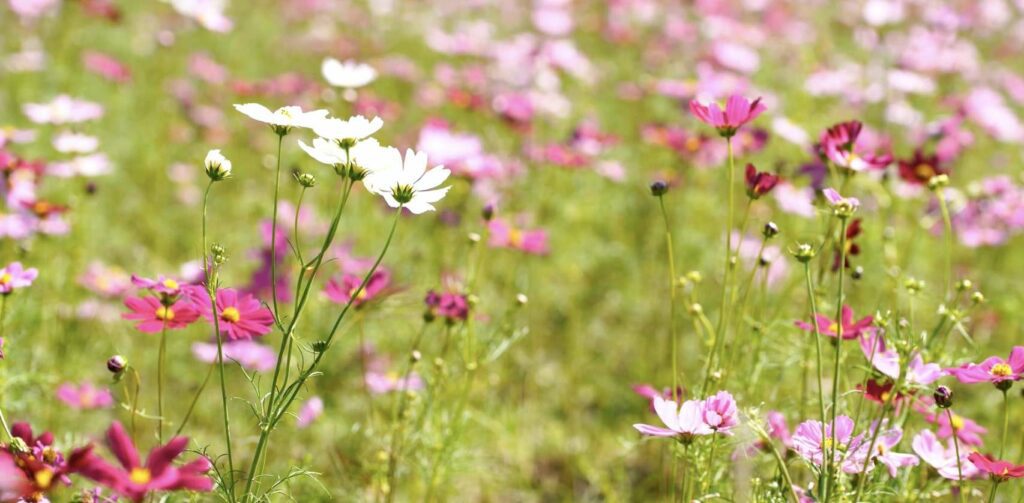

Genus: Aster
Family: Asteraceae
Native habitat: Europe and Asia
Preferred climate: Moist, cool summers and nights
Blooming time: Late summer through early fall
Mature size: 1 to 6 feet tall, 1 to 4 feet wide
Suitable as: Garden bed, potted, and cut flowers
Aster is a genus of perennial flowering plants with roughly 170 varieties. They often have showy flowers that bloom from late summer through early autumn.
They belong to the extensive Asteraceae family that also includes chrysanthemums, dahlias, and daisies, the third of which closely resembles it.
Their native habitats are in Europe and Asia where they thrive in moist and cool summers and cold winters.
However, there are other species from North America that are also referred to as asters but are classified under two different genera.
What does an aster flower look like?
The most distinctive feature of the aster is its flower that’s shaped like a daisy or a twinkling star. Its large and narrow clusters of petals typically surround a bright yellow center.
These blooms come in bright hues such as pink, red, white, blue, and lavender. They contrast wonderfully with the dark green leaves and strong, woody stems of the plant.
Depending on the variety, they can grow from 1 to 6 feet tall and 1 to 4 feet spread. And so, this can make them the center of attraction in one’s garden or home interior.
Morning Glory General Information
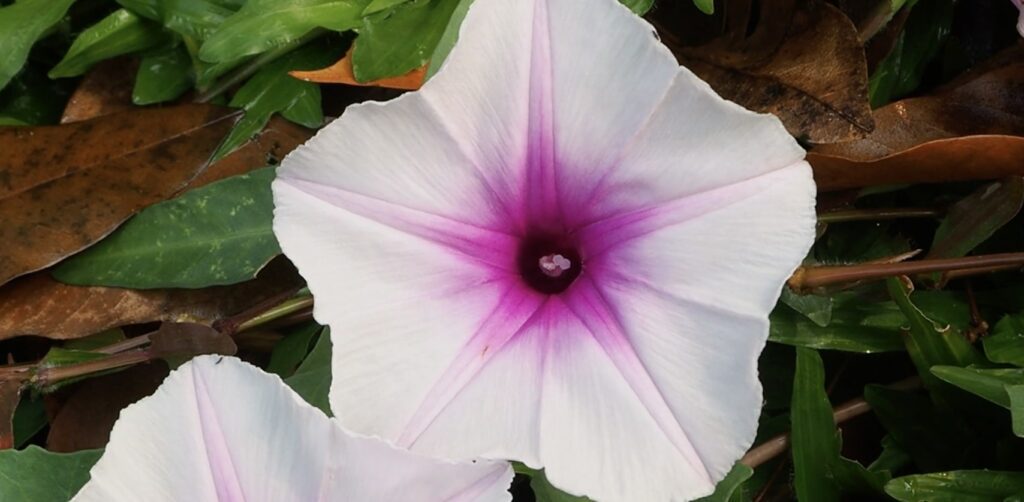

Genus: Ipomoea
Family: Convolvulaceae
Native habitat: South, Central, and North America
Preferred climate: Warm and humid
Blooming time: Early summer to early fall
Mature size: Up to 12 feet long
Suitable as: Garden, hanging basket, fence, arbor, and trellis-equipped potted flowers
On the other hand, Morning Glory (Ipomoea) is the common name for climbing vines or shrubs grouped under the large and currently changing Convolvulaceae family.
There are a lot of them in their native home in South and Central America as well as throughout North America.
Very hardy plants, morning glories can withstand both hot and cold climates after surviving the first frost.
Even so, they are usually grown more as annuals than perennials in the US due to its mostly cold weather.
They are also suitable to be grown in stylish hanging baskets and pots with trellis support. With them, the vines can grow upwards or cascade downwards in a dramatic fashion.
What does a morning glory flower look like?
Morning glories have unique, trumpet-like flowers that unfurl in the morning sun, a glowing center, and vines that extend and twine around various structures for support.
Their flowers come in pink, magenta, blue-purple, and white. Along with this, their slender stems bear elegant heart-shaped leaves with white and dark green marks.
Once they’re comfortable in the soil, they will grow rapidly up to 12 feet or longer in just a year. This is why in some regions they’re considered to be an invasive weed.
What’s more, their beautiful and fragrant flowers aren’t only pleasing to humans but also to pollinators like butterflies and hummingbirds.
Aster Symbolism
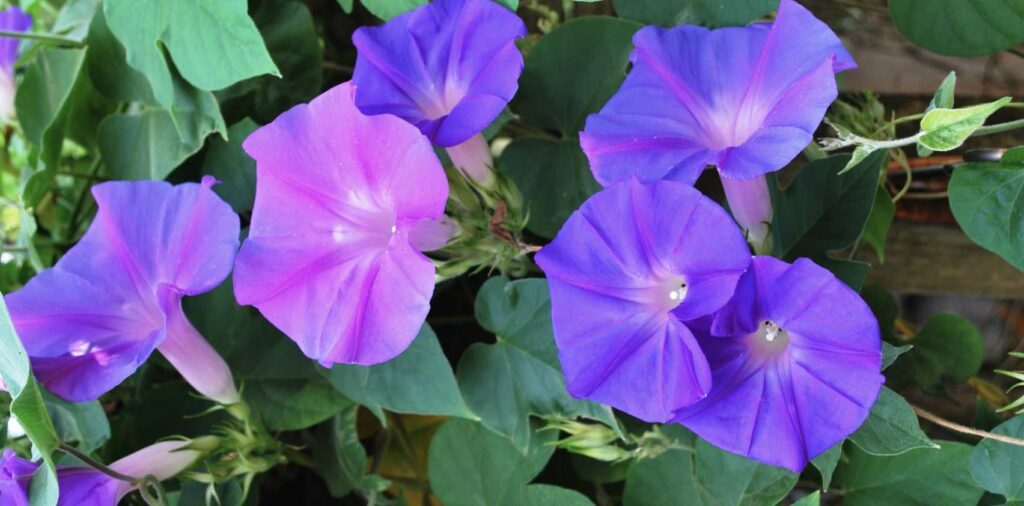

It’s no wonder that asters and morning glory have been paired as September birth flowers, as they both symbolize love but in different ways.
Asters are named after the Greek word for star (άστρο, pronounced as “astro”) due to their flower shape. They are associated with love, wisdom, courage, and faith.
Pretty and delicate with cheery colors, they also stand for daintiness, elegance, and a love of variety.
Morning Glory Symbolism
The morning glory means unreturned love, death, sleep, and life.
These meanings are explained by the fact that it naturally blooms openly and beautifully in the day and swirls closed at night. Its closing makes one recall sleep or death.
Asters in Culture and History
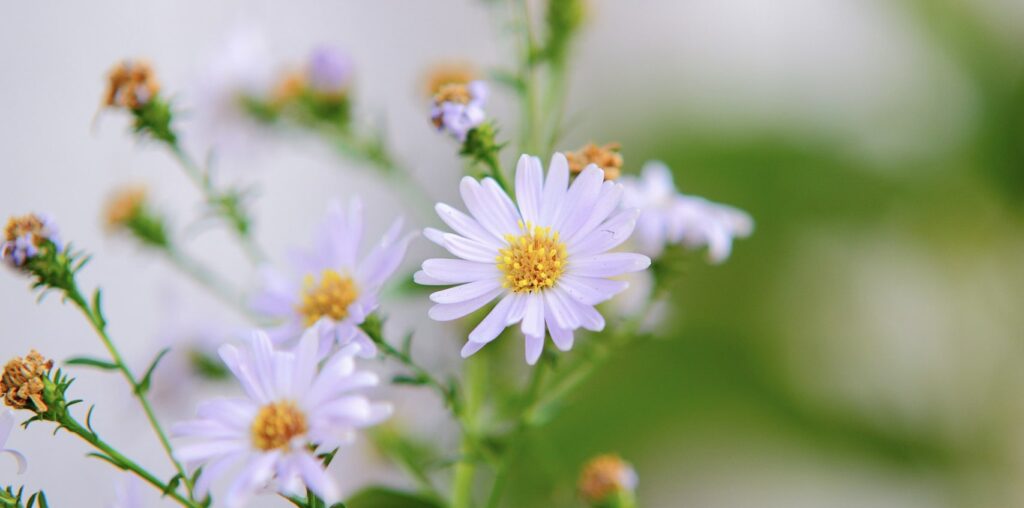

Here’s how the aster is regarded in different cultures:
Asters in America
American poet Robert Frost used the aster flower to represent hope in his acclaimed poem “A Late Walk.”
Asters in Europe
Legendary painter Claude Monet notably painted Asters in 1880 featuring wonderful asters on a vase in an impressionistic style.
Also, Vincent Van Gogh, the great and beloved artist, did a superb work entitled Vase with Chinese Asters and Gladioli with a crimson backdrop in 1886.
Asters in Greece
Asters appear many times in Greek mythology and history.
This flower was often placed on altars as an offering to Greek gods when the ancient Greeks asked for something they needed, gave thanks, or celebrated festivals.
Furthermore, its origin story in Greek involves Astraea, the Greek goddess of justice, purity, and innocence.
It was said that she cried after seeing that there were no stars in the dark blanket of the sky. Where her tears fell on Earth, star-shaped asters sprang forth.
Asters in Hungary
After the devastating effects of World War I, a lot of Hungarians wore asters on their hats and protested on the streets of Budapest.
This crucially led to the formation of the First Hungarian People’s Republic, which allowed Hungary to gain its independence from Austria.
Since the aster was used as a symbol during this important time, this revolution is now called the Aster or Chrysanthemum Revolution.
Morning Glories in Culture and History
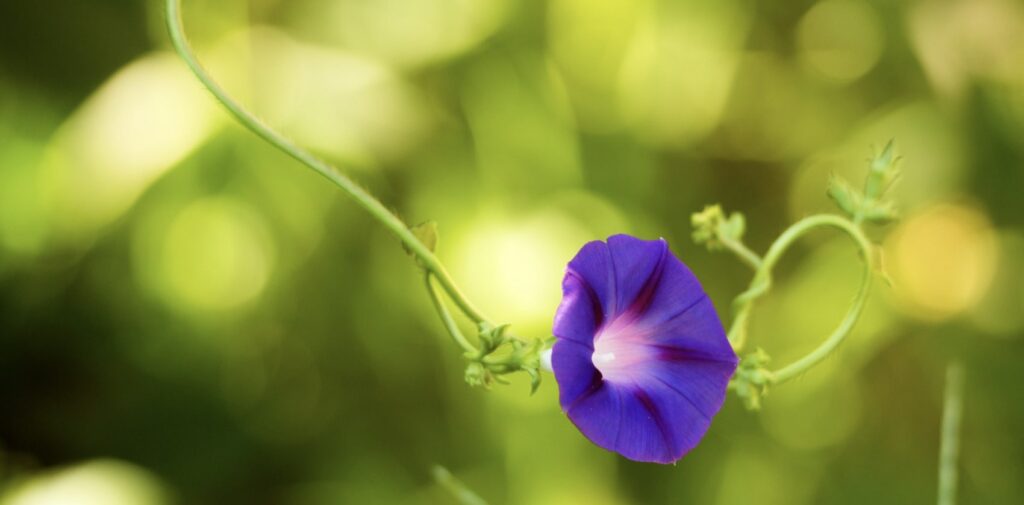

Here’s what the morning glory means in different nations:
Morning Glories in China
In China, the ethereal morning glory symbolizes forbidden love between two people. This notion is taken from a popular Chinese folk tale.
It’s about two star-crossed lovers, Chien Niu and Chih Neu, who fell so madly in love with each other that they completely ignored the celestial duties given to them.
In seeing this, the gods became angry and separated the two of them as punishment. They were deeply hurt by this, but they showed mercy by letting the lovers see each other once a year.
The morning glory represents the one day in the entire year these lovers are allowed to meet.
This is also connected to the fact that morning glories exist only for one day. They reveal their impressive flowers in the morning and start to fade and wilt at twilight.
Morning Glories in England
Morning glories were called “the life of man” in some remote countrysides of England. The reason for this is that the deeply cupped flower with a radiant center represented life to the English.
Moreover, in Victorian times, morning glory was regarded as a symbol of short life, death, and mourning, as it was often seen twining over headstones and gravesites.
Still, some Englishmen looked at this flower as a symbol of rebirth or a new beginning because they believed that life keeps cycling from birth to death and vice versa.
Aside from that, it is assigned the meaning of failed love in floriography or the Victorian language of flowers.
Morning Glories in Mexico
In the time of the Aztecs, the inhabitants of Central Mexico from the 14th to early 16th century, morning glory seeds were combined with tobacco and insects to form a certain mixture.
This mixture was then rubbed on the body of a person who was to be sacrificed in a ritual for the gods to please them. It was also believed that this ensured that the sacrificial person will get to the afterlife or will be reborn.
What is the occasion for gifting asters?


You can give a wrapped aster bouquet to a friend or relative. Like daisies, the sunny colors of asters can lift their mood and make them smile big irrespective of the occasion.
Because it also means beauty, purity, and innocence, you can give it to your spouse or lover on Valentine’s Day, your wedding day, or your anniversary in place of roses or sunflowers.
How to Gift Morning Glories
You have to be a bit careful when giving a morning glory because of its undesirable meanings.
At best, this can be given in vase form with different variations of its colors. With this, the negative meaning can be superseded by the positive and all that the person will notice are the impressive fan flowers and colors.
Plus, the plant can be given in a captivating pot vessel with a trellis. The heart-shaped foliage, long vines, and trumpet-shaped flowers will surely add a rustic charm to someone’s garden or deck.
How to Take Care of Asters


Below is a list of care requirements for asters.
- Sunlight
Asters need full sun in order to grow at their very best. They can withstand filtered or dappled sun, but they will grow slower and develop fewer blooms as a result.
- Soil
Give an aster loamy, fertile, and well-drained soil. This provides it with great drainage, moisture retention, and airflow, all of which give it the ideal growing environment.
Soil like clay will lead to root rot, as it absorbs more water, while one with more sand will cause the plant to wilt, as the water will flow right through them.
- Temperature and Moisture
Asters thrive in cooler climates in USDA hardiness zones 3 to 8.
These regions have temperatures ranging from -40℉ to 20℉, which means they can withstand some frost and still continue growing like normal.
Additionally, it needs a relative humidity of 50 to 60 percent so that its soil won’t dry up very quickly.
- Watering
After you have planted your asters in the garden bed or a potted container, water them at least once a week when the soil has turned dry.
If the weather is sweltering and humid, you’d have to water these climbing plants more often. Note that when their roots are established in the soil, they become drought-hardy.
- Fertilizing
Feeding asters with plant food is crucial to their growth. They need to be fed a good-quality balanced fertilizer twice a month in spring before the first blooms emerge.
Once you see the first signs of flowering, stop feeding them altogether. Otherwise, you will cut their amazing flower show short.
- Pruning
Remove dead aster flowers or leaves in spring to encourage new flowers and leafier growth. You can take out as many as 1/3 of them, but don’t worry, as they will grow new ones.
And during the winter, it is your choice whether to cut back the leaves or leave them alone so they can continue to decorate your home.
- Repotting
You must repot the aster when its roots outgrow the pot vessel. Make sure that the pot you transfer it to has drainage holes so that the excess water can come out of them.
Once you have done this, water the plant generously until it is established, and place it somewhere where it gets full sunlight for six to eight hours each day.
How to Take Care of Morning Glories
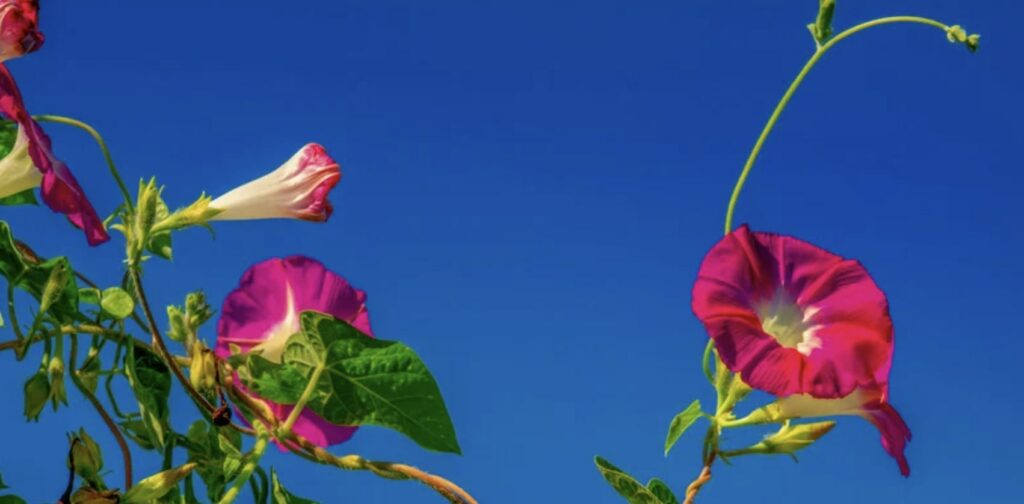

Here are what morning glories need to grow healthily.
- Sunlight
Whether you grow a morning glory indoors or outdoors, it needs bright direct sun for six to eight hours daily. So place them in a south or southeast-facing window within a distance of 2 to 3 feet.
- Soil
As for their ideal soil, morning glories need moderately organic and damp soil with great drainage.
This is only when the plant is still young. When it becomes an adult, it won’t be as choosy of its soil.
It can tolerate poor and dry soil, although it won’t grow as healthily and abundantly compared to if it had the right soil.
- Temperature and Moisture
Morning glory fares well in warm and humid weather between 68℉ and 95℉. It can tolerate frosty conditions but not as much as tropical climates.
Furthermore, the humidity has to be set to high at more than 50 percent. Just a tip: you can put mulch around the plant to help it retain moisture.
- Watering
Water a morning glory’s top inch of soil at least once every week. But water more when the plant is growing until it is established in the soil.
- Fertilizing
While morning glory can continue to grow without any fertilizer, their flowers won’t be as large or bountiful as if you feed them with it.
Use a 10-10-10 balanced fertilizer every month in its growing season from early spring to early fall.
- Pruning
Ordinarily, morning glories don’t require pruning except during the winter when their foliage dies.
However, during the growing season, you can always prune or trim them if their stems or leaves have become too bushy.
- Repotting
Annual morning glories don’t need to be repotted, whereas perennial ones would benefit from repotting every two to three years.
Speaking of which, be careful with their roots when you repot the plant.
Other Flowers That Bloom in September
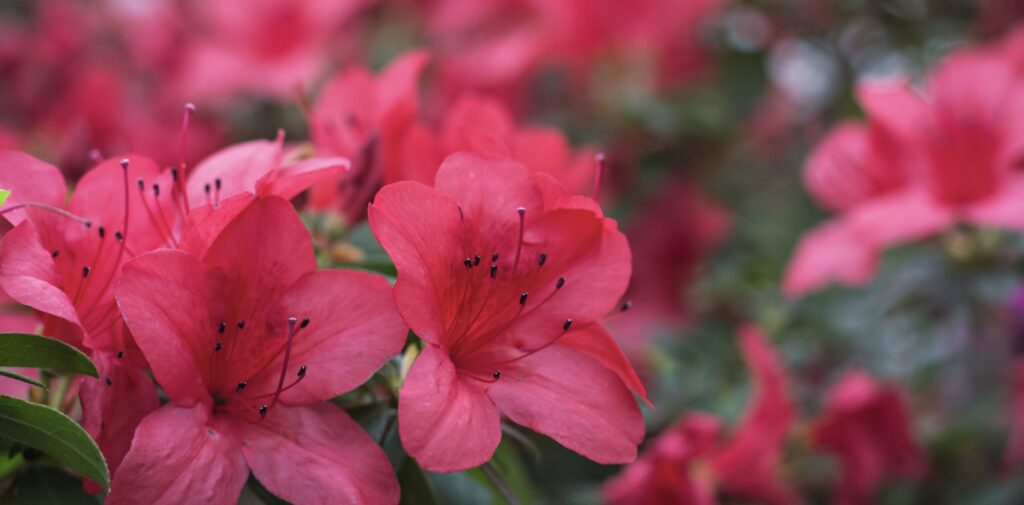

- Encore Azalea “Autumn Royalty” – It’s a magnificent magenta flower that blooms in autumn. It is indeed eye-catching and colorful if grown as shrubs or herbs in the garden.
- Blue Cardinal Flower – Another fall favorite, the Blue Cardinal Flower grows showy blue blossoms directly from its sturdy, leafy stalk. You can sight hummingbirds if you grow this flower at your place.
- Begonia “Alba” – It features large delicate white blooms with bronze-colored leaves with red undersides.
- Rose “Francois Rabelais” – It’s a unique kind of red rose with graceful and ruffled petals. New roses of this variety are darker red and more fragrant than old ones.
- Osmanthus – This one grows a cluster of narrow-petalled white flowers on a woody stalk. It is very elegant in appearance, making it a fantastic September flower.



